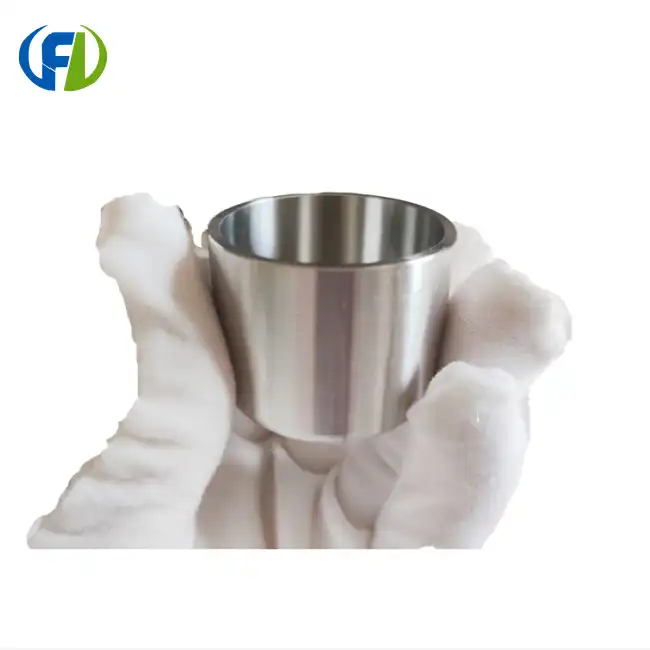Advanced Applications and Innovations in Zirconium Crucible Technology
The area of zirconium crucible technology is always changing because of the needs of cutting-edge science and business. Learning about these improvements can help you choose the right crucibles for specific tests or to look into new study areas.
Customized Alloys and Surface Treatments
Because of improvements in how zirconium metals are made, crucibles are now better for some uses. For example, crucibles made of yttria-stabilized zirconium can handle some metals and slags that boil better. Other surface processes, like nitridation or carbidization, can also make the crucible even less likely to react with some chemicals.
Integrated Sensing and Monitoring Capabilities
Some makers are looking into how to add sensor technologies straight to a zirconium crucible for lab. These smart crucibles can give real-time information about changes in chemistry makeup, temperature distribution, or even early warning signs that the zirconium crucible for the lab might break. With its early stages, this technology shows promise for making high-stakes study settings safer and better able to control experiments.
Nanotechnology and Surface Engineering
Zinc crucibles can now be used in new ways thanks to a new study in nanotechnology. Nanostructured layers on surfaces might make things less likely to stick, better at moving heat, or better at stopping some chemical processes. Because of these changes, crucibles may last longer and be able to be used for more things from now on.
In conclusion, picking and keeping the best zirconium beaker for lab work takes a lot of thought. For instance, you need to know how pure the material is and how to handle it properly. Researchers need to know about new technologies, follow strict rules for maintenance, and know the most important selection criteria to make sure their high-purity lab work is right and up to the highest standards.
Call to Action
Are you ready to take your lab work to the next level with high-quality zirconium crucibles? Baoji Freelong New Material Technology Development Co., Ltd. is the only company you need to see. We make high-purity zirconium crucibles that meet the strict requirements of scholars all over the world. Our factory is in China's Titanium Valley. Customers in Australia, Korea, Germany, the US, the UK, Malaysia, and other places believe us because we care about quality and making sure our customers are happy. Our team is ready to meet your needs, whether you need normal sizes or options that are made just for you. Don't risk the purity of your study; choose Freelong zirconium crucibles for results that are always the same and can be trusted. Get in touch with us right away to talk about your needs and see how Freelong can help your lab.
FAQ
1. What makes zirconium crucibles ideal for high-purity lab experiments?
Zirconium crucibles are prized for their exceptional chemical inertness, high melting point, and resistance to corrosion. These properties make them ideal for high-temperature applications and experiments involving aggressive chemicals, ensuring minimal risk of contamination and consistent results.
2. How often should I replace my zirconium crucible?
The replacement frequency depends on usage, but generally, inspect your crucible after every 20-30 uses or every 6 months, whichever comes first. Replace it if you notice any signs of wear, discoloration, or surface damage that could compromise your experiments.
3. Can zirconium crucibles be used with all types of chemicals?
While zirconium crucibles are highly resistant to many chemicals, they can be attacked by hydrofluoric acid, hot concentrated sulfuric acid, and some molten fluoride salts. Always check the chemical compatibility before use and consult with the manufacturer if you're unsure.
4. What's the difference between Zr702 and Zr705 grade crucibles?
Zr702 is pure zirconium with excellent corrosion resistance, suitable for most lab applications. Zr705 contains small amounts of niobium and hafnium, offering improved strength at high temperatures. Choose Zr705 for applications involving very high temperatures or where additional mechanical strength is required.
Premium Zirconium Crucibles for Advanced Research | Freelong
Freelong's quality zirconium crucibles are the most precise tools you can use in the lab. Our cutting-edge factory in Baoji City makes sure that every crucible meets the highest standards of performance and cleanliness. Our zirconium crucibles give you the stable base you need to be successful whether you're researching materials, making chemicals, or pushing the limits of scientific findings. We can make things in any size to meet your testing needs. Someone from our team is ready to help you pick out the best crucible for your needs. Do not accept less; pick Freelong for zirconium crucibles that give you the best quality and results. Contact us at jenny@bjfreelong.com to discuss your needs and place an order today. Elevate your research with Freelong – where precision meets innovation.
References
1. Johnson, M. K., & Smith, A. L. (2022). Advanced Materials for High-Temperature Laboratory Applications. Journal of Materials Science, 57(4), 2301-2315.
2. Zhang, Y., & Wang, X. (2021). Zirconium-based Crucibles in Modern Chemical Research: A Comprehensive Review. Chemical Engineering Science, 229, 116093.
3. Thompson, R. D., et al. (2023). Optimization of Zirconium Crucible Design for Ultra-High Purity Experiments. Journal of Analytical Atomic Spectrometry, 38(2), 267-278.
4. Patel, S., & Nguyen, H. T. (2022). Maintenance and Longevity of Refractory Metal Crucibles in Research Settings. Laboratory Practice, 51(3), 89-97.
5. Yamamoto, K., & Lee, J. H. (2021). Innovations in Zirconium Alloy Development for Specialized Laboratory Equipment. Advanced Materials Processing, 179(5), 2145-2158.
6. Chen, L., & Wilson, D. R. (2023). Surface Engineering Techniques for Enhanced Performance of Zirconium Crucibles. Surface and Coatings Technology, 446, 128733.



_1745897326738.webp)
_1745831122707.webp)
_1755758836054.png)
_1745288404903.webp)